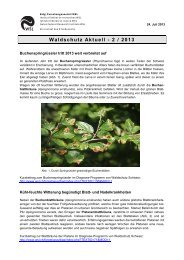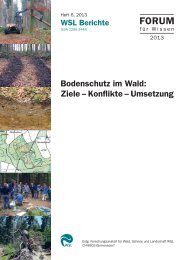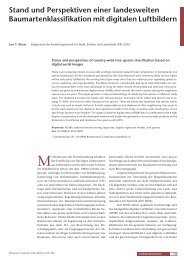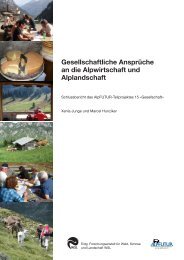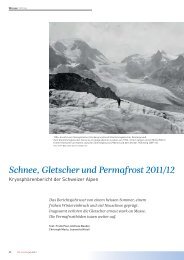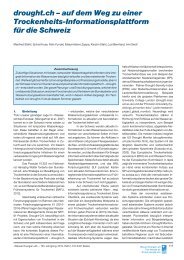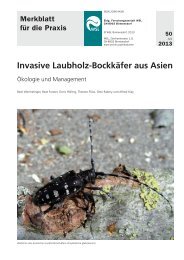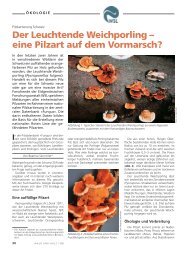Ecology and management of the spruce bark beetle Ips ... - WSL
Ecology and management of the spruce bark beetle Ips ... - WSL
Ecology and management of the spruce bark beetle Ips ... - WSL
Create successful ePaper yourself
Turn your PDF publications into a flip-book with our unique Google optimized e-Paper software.
76<br />
10.3. Fur<strong>the</strong>r techniques<br />
Conventional chemical insecticides are mostly<br />
used to protect stored timber. Their application varies<br />
according to <strong>the</strong> legislation in different countries.<br />
Systemic chemicals have been reported to protect<br />
single susceptible trees (Dedek <strong>and</strong> Pape, 1990; Bombosch<br />
et al., 1992; Bombosch <strong>and</strong> Dedek, 1994).<br />
Biological agents, which are partly established in<br />
agriculture, have not yet been commercially applied<br />
against <strong>the</strong> <strong>spruce</strong> <strong>bark</strong> <strong>beetle</strong>. Among pathogens <strong>the</strong><br />
fungus Beauveria bassiana (Bals.) Vuill. has been<br />
tested for biological control (Vaupel <strong>and</strong> Zimmermann,<br />
1996; Kreutz, 2001). The <strong>of</strong>fspring production<br />
<strong>of</strong> females contaminated with fungal spores in modified<br />
pheromone traps was up to 53% <strong>of</strong> <strong>the</strong> control.<br />
However, <strong>the</strong> fungus was not passed on to <strong>the</strong> progeny<br />
(Vaupel <strong>and</strong> Zimmermann, 1996). There are technical<br />
<strong>and</strong> ecological limitations to <strong>the</strong> application <strong>of</strong> spores<br />
to timber or to <strong>the</strong> forest litter containing overwintering<br />
I. typographus.<br />
10.4. Managed forests <strong>and</strong> forest reserves<br />
Unmanaged <strong>spruce</strong> forests do not necessarily have<br />
higher populations <strong>of</strong> I. typographus. In a Swedish<br />
study (Schlyter <strong>and</strong> Lundgren, 1993), <strong>bark</strong> <strong>beetle</strong><br />
densities were similar or even lower than in surrounding<br />
managed forests. However, after disturbances,<br />
such as storms or fire, <strong>the</strong> populations in unmanaged<br />
forests are very likely to rise to epidemic levels<br />
(Schlyter <strong>and</strong> Lundgren, 1993).<br />
Large infestation spots are said to pose a threat to<br />
adjacent st<strong>and</strong>s up to approximately 500 m away<br />
(Schröter, 1999; Wichmann <strong>and</strong> Ravn, 2001). Intensely<br />
managed forests that are adjacent to forest<br />
reserves are supposed to have a higher risk <strong>of</strong> <strong>bark</strong><br />
<strong>beetle</strong> infestation (Becker, 1999). However, this is<br />
presumably not exclusively <strong>the</strong> result <strong>of</strong> emigration<br />
<strong>of</strong> <strong>beetle</strong>s from <strong>the</strong> reserves. When a storm triggers an<br />
outbreak in a reserve, it most probably also weakens<br />
<strong>the</strong> adjacent st<strong>and</strong>s. Thus, <strong>the</strong>se st<strong>and</strong>s are more<br />
susceptible to attack <strong>and</strong> have probably fostered <strong>the</strong>ir<br />
own local I. typographus populations as well.<br />
In some cases (e.g. in <strong>the</strong> German National Parks<br />
‘Bavarian Forest’ <strong>and</strong> ‘Harz’) phytosanitary protection<br />
zones have been established around reserves with<br />
I. typographus gradations. The control <strong>of</strong> <strong>the</strong> <strong>beetle</strong>s in<br />
B. Wermelinger / Forest <strong>Ecology</strong> <strong>and</strong> Management 202 (2004) 67–82<br />
<strong>the</strong>se buffer zones has proven difficult <strong>and</strong> laborintensive<br />
because <strong>of</strong> <strong>the</strong> size <strong>of</strong> <strong>the</strong> area to be monitored<br />
<strong>and</strong> <strong>the</strong> continuing supply <strong>of</strong> <strong>beetle</strong>s from <strong>the</strong><br />
reserve. In practice, buffer zones between 100 m<br />
(Niemeyer et al., 1995a) <strong>and</strong> 1500 m (Heurich et<br />
al., 2001) have proven efficient <strong>and</strong> prevented significant<br />
attacks in adjacent managed forests.<br />
A sustainable strategy to reduce <strong>the</strong> risk <strong>of</strong> I.<br />
typographus attack in managed <strong>spruce</strong> forests in <strong>the</strong><br />
long term is to reduce <strong>the</strong> proportion <strong>of</strong> <strong>spruce</strong> <strong>and</strong> to<br />
form heterogeneous st<strong>and</strong>s. Multi-tree species forests<br />
are <strong>of</strong>ten less susceptible to <strong>bark</strong> <strong>beetle</strong> attack. This<br />
may be <strong>the</strong> result <strong>of</strong> <strong>the</strong>re being fewer <strong>and</strong> less<br />
susceptible host trees, <strong>of</strong> natural enemy effects, or<br />
<strong>of</strong> volatiles <strong>of</strong> non-host trees interfering with <strong>bark</strong><br />
<strong>beetle</strong> pheromone communication (Byers et al., 1998;<br />
Zhang et al., 1999).<br />
10.5. Risk assessment<br />
From <strong>the</strong> forest manager’s point <strong>of</strong> view it is crucial<br />
to assess <strong>the</strong> risk <strong>of</strong> a st<strong>and</strong> being attacked by I.<br />
typographus. For this purpose different approaches<br />
have been used including GIS <strong>and</strong> regression analyses<br />
(Lexer, 1995; Dutilleul et al., 2000; Wichmann <strong>and</strong><br />
Ravn, 2001). St<strong>and</strong>s at most risk were those neighboring<br />
windthrows harvested after <strong>the</strong> first <strong>beetle</strong> generation<br />
<strong>and</strong> those within 500 m <strong>of</strong> an old attack<br />
(Wichmann <strong>and</strong> Ravn, 2001). Pheromone traps are<br />
not a reliable means <strong>of</strong> evaluating <strong>the</strong> risk (cf. Section<br />
10.2). However, several site <strong>and</strong> silvicultural characteristics<br />
seem to be related to attack probability<br />
(mainly water availability <strong>and</strong> slope, Lexer, 1995).<br />
Physiological predictors at <strong>the</strong> single tree level (water<br />
status, nutrients, phenolics, resin; cf. Section 8.1)<br />
seem to be less suited for <strong>the</strong> risk assessment <strong>of</strong><br />
complete st<strong>and</strong>s.<br />
11. Discussion<br />
The <strong>spruce</strong> <strong>bark</strong> <strong>beetle</strong> I. typographus is an essential<br />
component <strong>of</strong> every <strong>spruce</strong> forest ecosystem. As a<br />
pioneer it colonizes dying <strong>and</strong> newly dead trees <strong>and</strong><br />
thus starts <strong>the</strong> decomposition <strong>of</strong> <strong>bark</strong> <strong>and</strong> wood. As a<br />
typical r-strategist, it is able to exploit short-lived<br />
resources <strong>and</strong> to rapidly multiply, e.g. after windthrows,<br />
to extremely high numbers. When <strong>the</strong> fallen



